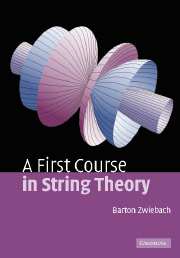Book contents
- Frontmatter
- Contents
- Foreword
- Preface
- Acknowledgements
- Part I Basics
- 1 A brief introduction
- 2 Special relativity and extra dimensions
- 3 Electromagnetism and gravitation in various dimensions
- 4 Nonrelativistic strings
- 5 The relativistic point particle
- 6 Relativistic strings
- 7 String parameterization and classical motion
- 8 World-sheet currents
- 9 Light-cone relativistic strings
- 10 Light-cone fields and particles
- 11 The relativistic quantum point particle
- 12 Relativistic quantum open strings
- 13 Relativistic quantum closed strings
- Part II Developments
- References
- Index
4 - Nonrelativistic strings
from Part I - Basics
- Frontmatter
- Contents
- Foreword
- Preface
- Acknowledgements
- Part I Basics
- 1 A brief introduction
- 2 Special relativity and extra dimensions
- 3 Electromagnetism and gravitation in various dimensions
- 4 Nonrelativistic strings
- 5 The relativistic point particle
- 6 Relativistic strings
- 7 String parameterization and classical motion
- 8 World-sheet currents
- 9 Light-cone relativistic strings
- 10 Light-cone fields and particles
- 11 The relativistic quantum point particle
- 12 Relativistic quantum open strings
- 13 Relativistic quantum closed strings
- Part II Developments
- References
- Index
Summary
A full appreciation for the subtleties of relativistic strings requires an understanding of the basic physics of nonrelativistic strings. These strings have mass and tension. They can vibrate both transversely and longitudinally. We study the equations of motion for nonrelativistic strings and develop the Lagrangian approach to their dynamics.
Equations of motion for transverse oscillations
We will begin our study of strings with a look at the transverse fluctuations of a stretched string. The direction along the string is called the longitudinal direction, and the directions orthogonal to the string are called the transverse directions. We consider, for notational simplicity, the case when there is only one transverse direction – the generalization to additional transverse directions is straightforward.
Working in the (x, y) plane, let the classical nonrelativistic string have its endpoints fixed at (0, 0), and (a, 0). In the static configuration the string is stretched along the x axis between these two points. In a transverse oscillation, the x-coordinate of any point on the string does not change in time. The transverse displacement of a point is given by its y-coordinate. The x direction is longitudinal, and the y direction is transverse. To describe the classical mechanics of a homogeneous string, we need two pieces of information: the tension T0 and the mass per unit length μ0. The total mass of the string is then M = μ0a.
- Type
- Chapter
- Information
- A First Course in String Theory , pp. 65 - 77Publisher: Cambridge University PressPrint publication year: 2004



